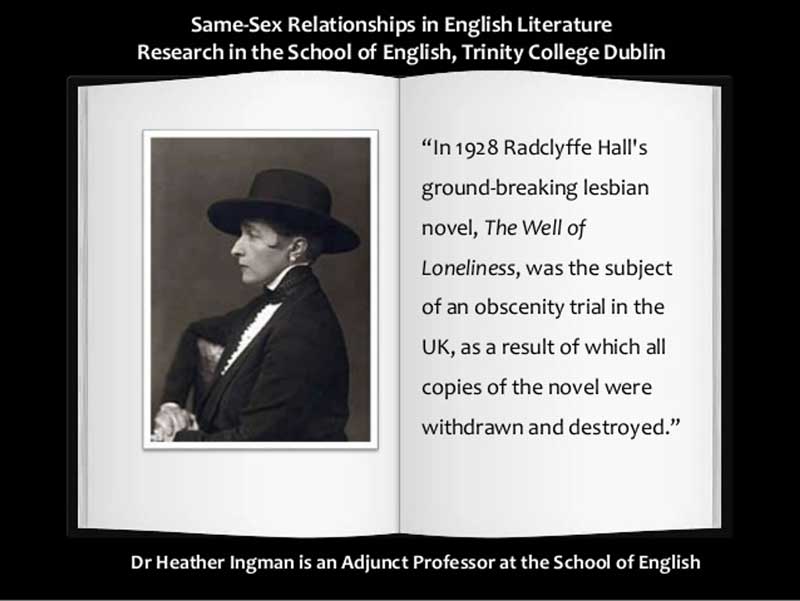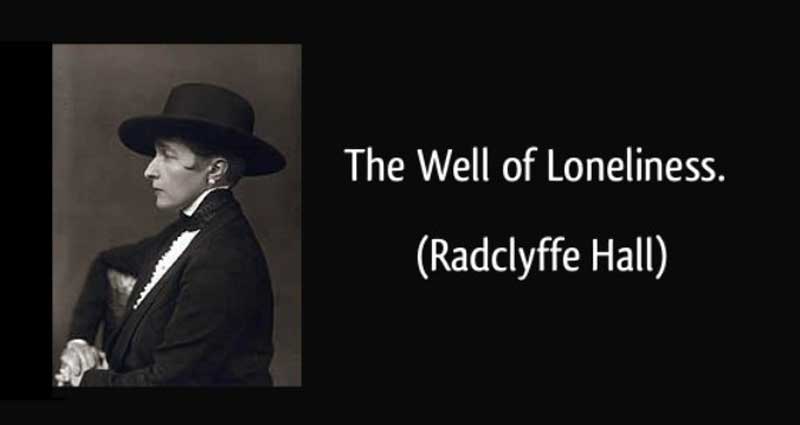
Initially published in England in 1928 by Jonathan Cape, the Well of Loneliness is a lesbian novel, written by British author Radclyffe Hall. It follows the life story of Stephen Gordon, born to upper-class parents in Worcestershire. Her parents expected a boy and they christen the girl with the name they had already chosen for the male child. Since her childhood, Stephen was not like the other girls. Her physical structure was not girlish, as she was narrowly-hipped and wide shouldered, like a boy. Unlike girls of her age, she hated dresses, wanted to cut her hair short, and longed to be a boy. At seven, she had an ardent attachment, almost a crush, on a housemaid named Collins, and is devastated when she accidentally saw Collins kissing a footman.
Stephen's affectionate father, Sir Phillip, tried to go deeper to understand her attitude and mentality through the writings of Karl Heinrich Ulrichs, considered as the first writer to propose a theory of homosexuality. But, he never shared his views or findings with Stephen. Her mother, Lady Anna, was aloof, detached and disgusted about her. When she was eighteen, Stephen formed a close friendship with a Canadian man, Martin Hallam, but became horrified when he expressed his love for her. The following winter, a falling tree crushed Sir Phillip and at the last moment of his life he desperately tried to explain to her wife that Stephen is an invert, but he died before he could do so.

During this time Stephen becomes desperate and finally begins to dress like a man made by a tailor and at the age of twenty-one falls in love with a woman, Angela Crossby, the American wife of a new neighbour. However, Angela used Stephen as a tool for recreation, a new way to fight against her boredom and she playfully allowed her school girlish kisses. Gradually, Stephen discovers that Angela is having an affair with a man. Angela became scared of the exposure, as she thought Stephen may expose her extramarital affair to her husband simply out of jealousy.
To save herself from any such unwanted situation, she produced a letter from Stephen to her husband, who in turn forwarded a copy to Stephen's mother. Lady Anna denounces Stephen for her filthy and unnatural cravings for a woman and blamed her unstable mind and unrestrained body. In reply Stephen made her point clear and said that, her love for Angela Crossby is pure and she loves her, just like her father loves his wife. After making it clear to her mother, Stephen goes to her father's study and for the first time opens his locked bookcase. She finds a book by Krafft-Ebing, a text about homosexuality and paraphilias. Finally, she learns that she is a homosexual.

Stephen left home and moves to London. Her first novel, The Forge (1924), was an instant success and made the bestseller list of John O'London's Weekly. However, The Unlit Lamp (1924), published after that, was a lengthy and a grim tale that proved hard to sell. At that stage, her friend the playwright Jonathan Brockett, himself a gay, urges her to travel to Paris to gather new experience about life to improve her writing through a new vista. She followed the advice and in Paris makes her first, brief contact with urban invert culture and met Valérie Seymour, hostess of a lesbian salon.

During World War I Stephen joins an ambulance unit. Eventually she served at the front and was awarded the Croix de Guerre, a military decoration of France. There she met and fell in love with a younger fellow driver, Mary Llewellyn, who comes to live with her after the end of the war. They started to live happily, but soon Mary becomes lonely when Stephen returns to her desk for writing. Rejected by the aristocrat polite society, Mary throws herself into Parisian nightlife.
Stephen could feel Mary’s suffering, but could do nothing about that, as she was unable to give her more time and attention and provide her with a more normal and complete existence. However, the situation was saved strangely. Martin Hallam, now living in Paris, rekindles his old friendship with Stephen and in time falls in love with Mary. Stephen took the opportunity. She pretends to have an affair with Valérie Seymour, only to drive Mary into Martin's arms.
The Well of Loneliness ends with Stephen's plea to God: Give us also the right to our existence.

It was considered by many that ‘The Well of Loneliness’ is a thinly veiled autobiography of Marguerite Radclyffe-Hall, born in Hampshire in 1880. Her mother, Marie Diehl, an American widow, married Radclyffe-Hall, grandson of a wealthy and knighted Lancashire physician. He was extravagant and a womanizer. Soon he left his new wife, months before Marguerite was born. Marguerite’s mother later remarried, but the child was ignored by both the parents and grew up lonely and restless. Nevertheless, she was educated at King's College London and studied further in Germany. There, in 1907, she met Mabel Batten, with whom she developed a relationship that lasted until Mabel's death in 1916. Mabel gave her the nickname ‘John,’ which she would use the rest of her life and all her friends and associates addressed her by that name only. However, her readers and fans knew her as Radclyffe.

From1917, Radclyffe-Hall began living with sculptor Una Troubridge, whom she had met in 1915. Their relationship would last until Radclyffe-Hall's death of colon cancer in 1943. In 1930 she was awarded the Gold Medal of the Eichelbergher Humane Award.

The background of the Well of Loneliness is in the early twentieth century, when the concept of lesbianism was completely unknown. During the days of the protagonist Stephen Gordon, any woman who was attracted to other women would have to consider herself a bizarre. It was against the church and the social ethics. The Well of Loneliness is marked with pain, anguish, loneliness, grief, suffering, and heartache, as lesbianism was considered as a vice in those days. It is, therefore, quite natural that the novel was banned for obscenity when published in 1928. The story, which got no more titillating than 'she kissed her full on the lips like a lover', led to an obscenity trial which even considered the strange implications of shortage of men in the society and two women in bed making beasts of themselves. It was also argued that, publication of the book would risk its being read by a large number of innocent persons, who might out of pure curiosity practice the form of the vice described in it. It was alleged that the book would encourage female homosexuality and lead to a social and national disaster. The magistrate eventually decided that the book was obscene and ordered that it be destroyed.

After the prohibition, the Well of Loneliness was not republished in England until 1952, nine years after the death of the author. However, it was not forgotten and has gone on to sell consistently in large quantities throughout the decades and around the world. The book enjoyed an English language readership abroad, as accusations of obscenity did not result in prosecutions in France and America. It has also been translated into 14 languages. Though it was not available in Britain, The Well’s lasting legacy in British culture was to make lesbianism more widely recognised as a cultural concept. The curse of censorship served to further popularize it and made Radclyffe Hall a hero for generations of lesbians. Within a short time it became an international bestseller and for decades was the single most famous lesbian novel.
